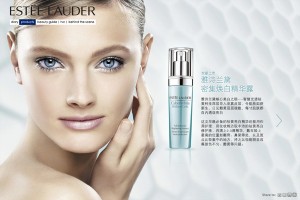Louisa Schein in The Consumption of Color and the Politics of White Skin in Post-Mao China, argues that the representation of white women overwhelms the contemporary Chinese world. She continues this argument by observing the denotations and connotations of the white woman’s body and facial features and attributes. Stein gives us 2 symbolic meanings of the western woman. The first being the physical meaning, the second being the ideological meaning. The physical meaning is the “emblem of radicalized difference which signifies not the blondness (or paleness) of western physical taxonomy”, but any color lighter than jet black or tan skin, which has unequivocal connotation of value. The ideological meaning is that the “White woman’s body has been written over by a multitude of other meanings including freedom, individualism, democracy, and progress. The white woman, or the western woman, that is featured in many Chinese advertisements denotes a soft, pale face, with a curvy body that not only insinuates sexuality, but also wealth and success. These connotations of the western woman developed a fetish for many Chinese women who also wanted to represent these ideas that, in their minds, couldn’t be achieved through Chinese fashion and culture.
nice thesis potential and extend it well
Lighter hair was also a cosmetic desire western women had that was sought out by Chinese women. Lighter hair in addition to lighter skin meant that you had more beauty value than if you had darker skin and hair.
Location, in other words, depending on where a Chinese woman is from, greatly effects whether or not Chinese women have access to the makeup that allows them to replicate the image of the western woman. Women who live further from cities and work outside a lot have darker, tanner skin as opposed to women who live close to or in cities that, due to less exposure to the sun, have paler, whiter skin tones. Therefore, the paler face connotes wealth in China because if you are wealthy you don’t have to work outside, if you have to work at all. This is an attractive aspect in China because it is the revival of femininity since Mao’s socialist China, where women were asked to be more masculine than feminine. However, although paler skin is the desirable look for Chinese women, it is mainly to attract and entice men.
use the ad as visual evidence to support the thesis statement, thereby tighten the organization
 In the photo to the left, there is a fair skinned, light-haired, young, western female posing for an ad advertising makeup. It’s clear that this woman is a model and has very attractive facial features that draw consumers to immediately stare at her beauty. Sometimes this stare can become a gaze of envy. Her bright blue eyes draw the consumer in like a black hole. Her skin is soft and if you look close enough, her skin is shining a little. Her skin in contrast with the white backdrop shows that she truly has a pale skin tone. Once the consumer has taken in all of this model’s beauty, the eyes immediately look for what product made this woman look this way. The make-up container that is juxtaposed to her face is the center of the photo, sharing an equal amount of focus with the actual model. The containers label says “CyberWhite, Brilliant Cells”. Because the container says “CyberWhite” on it, the ad is selling the luxury of having paler, whiter skin, as opposed to tan, darker skin.
In the photo to the left, there is a fair skinned, light-haired, young, western female posing for an ad advertising makeup. It’s clear that this woman is a model and has very attractive facial features that draw consumers to immediately stare at her beauty. Sometimes this stare can become a gaze of envy. Her bright blue eyes draw the consumer in like a black hole. Her skin is soft and if you look close enough, her skin is shining a little. Her skin in contrast with the white backdrop shows that she truly has a pale skin tone. Once the consumer has taken in all of this model’s beauty, the eyes immediately look for what product made this woman look this way. The make-up container that is juxtaposed to her face is the center of the photo, sharing an equal amount of focus with the actual model. The containers label says “CyberWhite, Brilliant Cells”. Because the container says “CyberWhite” on it, the ad is selling the luxury of having paler, whiter skin, as opposed to tan, darker skin.
nice description of the ad which can be divided into different sections according to different denotations/connotations
This ad is a perfect example of what Schein means when she says, “the passion for the Western Woman is a panacea, one that provides a focal point for Chinese longing and one that, in the process, effaces the subjectivity of Chinese women as women.” (Pg. 145) In this quote, Schein points out that the image of the Western woman is a solution for all difficulties faced by Chinese women to present themselves as “beautiful”. Furthermore, that this image of Western women makes the Chinese woman appear insignificant in contrast to the Western woman’s beauty. This explains the fetish that not only Chinese women have to be like the Western woman, but also that Chinese men have to desire the depiction of the Western woman. This is the reason why many Chinese women sought to lighten their skin tone, hair, and sometimes even change their facial structure to replicate the image of “Beauty” in reference to the Western thought for female beauty.
It would be very interesting to explain how the ad creates western fetish for Chinese consumers
